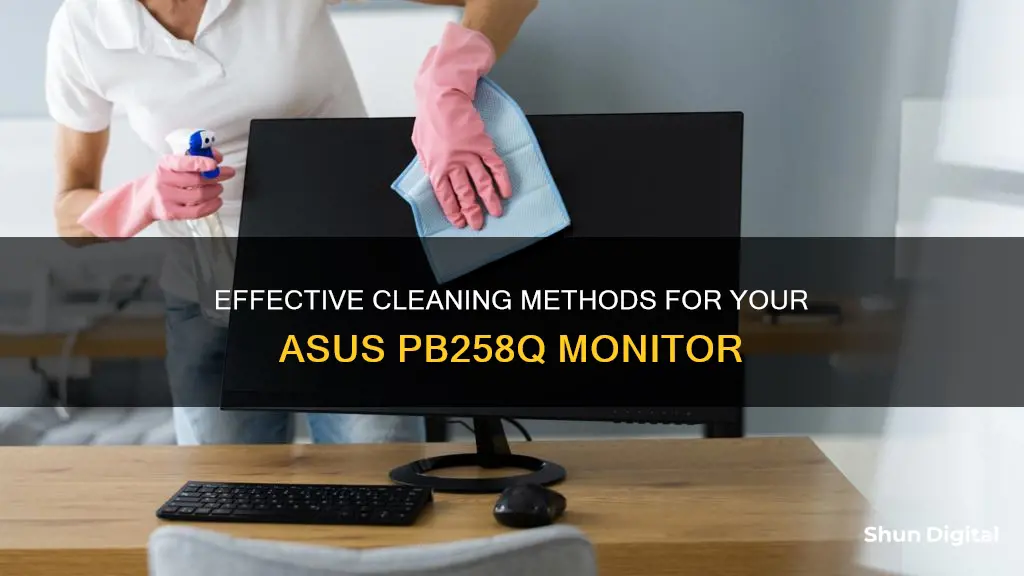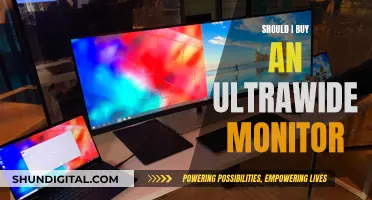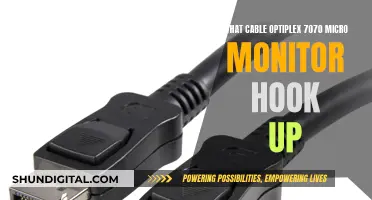
The ASUS PB258Q monitor is a 25-inch, 1440P display with an ergonomic design and an edge-to-edge frameless bezel. It is important to keep your monitor clean to ensure optimal viewing and prevent eye strain. Here is a step-by-step guide on how to safely and effectively clean your ASUS PB258Q monitor.
| Characteristics | Values |
|---|---|
| Screen Surface Description | Impeccable lifelike visuals with 25-Inch 16:9 2560 x 1440 with 100% sRGB and 178° wide-viewing angle |
| Stand | Ergonomically-designed with Tilt, Swivel, Pivot, and Height adjustment plus wall-mount capability for comfortable viewing position |
| Connectivity | Native WQHD content support with HDMI, DisplayPort, and Dual-link DVI |
| Technology | ASUS-exclusive QuickFit Virtual Scale and Splendid Video Intelligence Technology for true 'what you see is what you get' |
| Compliance and Standards | Energy Star, BSMI, CB, CCC, CE, CU, ErP, FCC, ISO-9241-307, J-MOSS, PSE, RoHS, TCO6.0, UL/cUL, VCCI, WHQL (Windows 8, Windows 7), MEPS, RCM |
| Cleaning | Before cleaning, turn the monitor off and unplug the power cord. First, remove any stubborn dirt with a lint-free, non-abrasive cloth and a neutral cleaning solution. Then gently wipe down the rest of the monitor. |
What You'll Learn

Unplug the monitor and use a lint-free, non-abrasive cloth with a neutral cleaning solution
To clean your ASUS monitor, it is important to first turn off and unplug the device. This is a crucial step to prevent damage or electric shock.
Next, you'll want to gather your cleaning tools. A good option is to use a lint-free, non-abrasive cloth, such as a microfiber cloth, and a neutral cleaning solution. Avoid using paper towels, standard rags, or tissues, as these can scratch the screen.
When choosing a cleaning solution, it is important to avoid certain substances. Do not use window cleaning fluid, Windex, or other products containing alcohol, acetone, or ammonia, as these can damage the screen's anti-reflective coating. Instead, opt for a gentle, neutral cleaning solution. You can create your own by mixing distilled water with white vinegar or a very small amount of rubbing alcohol (for non-LCD screens only).
Now, dampen your cloth with the cleaning solution. Be careful not to make it too wet, as you don't want moisture seeping into the edges of the screen. Gently wipe the screen in circular motions, applying minimal pressure to avoid damaging the pixels.
Finally, let the screen air dry completely before turning the monitor back on.
Monitoring KWH Usage: A Simple Guide to Energy Tracking
You may want to see also

Avoid abrasive materials like paper towels
It's important to take care when cleaning your ASUS PB258Q monitor to avoid any damage to the screen or exterior. One of the key things to remember is to avoid using abrasive materials or harsh chemicals during the cleaning process. This includes steering clear of paper towels, which may seem like a convenient option but can actually cause more harm than good.
Paper towels, despite their softness, contain wood fibers that can scratch and damage your monitor's screen. The wood fibers in paper towels are often not visible to the naked eye, but they can act like tiny pieces of grit or sandpaper when rubbed against the surface of your monitor. Over time, this can lead to fine scratches and a dull, cloudy appearance on your screen, impairing your viewing experience and the overall aesthetics of your monitor.
So, what should you use instead? It's recommended to opt for a soft, lint-free cloth specifically designed for cleaning electronics. Microfiber cloths are an excellent choice as they are gentle yet effective at picking up dust, dirt, and fingerprints. They are also less likely to generate static electricity, which can be a problem with some other types of cleaning cloths. If necessary, slightly dampen the microfiber cloth with distilled water, being careful not to let any liquid drip onto the monitor.
Another option is to use specialized screen-cleaning wipes or sprays designed for use on electronics. These products are formulated to be safe and effective on sensitive surfaces like LCD and LED screens. However, always read the instructions on the product label and test on a small, inconspicuous area of the monitor first to ensure compatibility.
OpenLM's Actual Usage Time: Monitoring and Management Strategies
You may want to see also

Don't spray liquid directly onto the screen
When cleaning your ASUS monitor, it is important to remember not to spray liquid directly onto the screen. This is because you risk damaging the screen by allowing liquid to seep into the monitor through the edges of the screen. Instead, it is recommended to dampen a cloth with a cleaning solution and use that to wipe down the screen.
Firstly, before cleaning, turn off the monitor and unplug the power cord. You can use a neutral cleaning solution or water, applied to a lint-free, non-abrasive cloth. You should then gently wipe down the screen, being careful not to press too hard on the screen as you do so.
After wiping the screen with the damp cloth, you should go over it again with a dry cloth to remove any excess liquid. This will ensure that no liquid remains on the screen, reducing the risk of damage. It is important to be gentle during this process and to use soft, non-abrasive materials to avoid scratching the screen.
By avoiding spraying liquid directly onto the screen, you can effectively clean your ASUS monitor while minimising the risk of damage. This method ensures that you have control over the amount of liquid used and that it is applied evenly across the screen.
Monitoring Children's Internet Usage: Parenting in the Digital Age
You may want to see also

Use water if you don't have a screen cleaning solution
If you don't have a screen cleaning solution, you can use water to clean your ASUS monitor. Firstly, before you lift or move your monitor, disconnect the cables and power cord. Then, lift or move the monitor by grasping its edges, not the stand or cord. Next, turn the monitor off and unplug the power cord. Take a lint-free, non-abrasive cloth—slightly dampen it with water—and use it to remove any stubborn dirt. Never spray water directly onto the screen or leave too much water on the screen. After this, gently wipe down the rest of the monitor with the cloth.
Once you've wiped the entire monitor, wait for the screen to dry. If there are still marks or stains on the screen, use a dry cloth to gently wipe from the top to the bottom of the screen, repeating this motion in the same direction.
Updating Your ASUS Monitor: A Simple Firmware Upgrade Guide
You may want to see also

Gently wipe the screen dry with a cloth after cleaning
To gently wipe the screen dry with a cloth after cleaning, use a dry cloth to gently wipe the screen from the top to the bottom. Repeat this motion in the same direction until all marks and stains are removed.
It is important to note that you should never spray cleaning solution directly onto the screen or leave too much solution on the screen. If you don't have a screen cleaning solution, you can use water instead.
Additionally, avoid using abrasive materials such as abrasive cloths, towels, or paper towels for wiping. Instead, use a lint-free, non-abrasive cloth.
Compatibility of ASUS Monitors with VESA Mounts
You may want to see also
Frequently asked questions
Before cleaning, turn the monitor off and unplug the power cord. First, remove any stubborn dirt with a lint-free, non-abrasive cloth and a neutral cleaning solution. Then gently wipe down the rest of the monitor. Avoid using abrasive materials such as abrasive cloths, towels, paper towels, or similar items for wiping.
Avoid using cleaners and sprays, bleach, or abrasives that contain alcohol or acetone. If you don't have a screen-cleaning solution, you can use water instead.
Use a lint-free, non-abrasive cloth.







